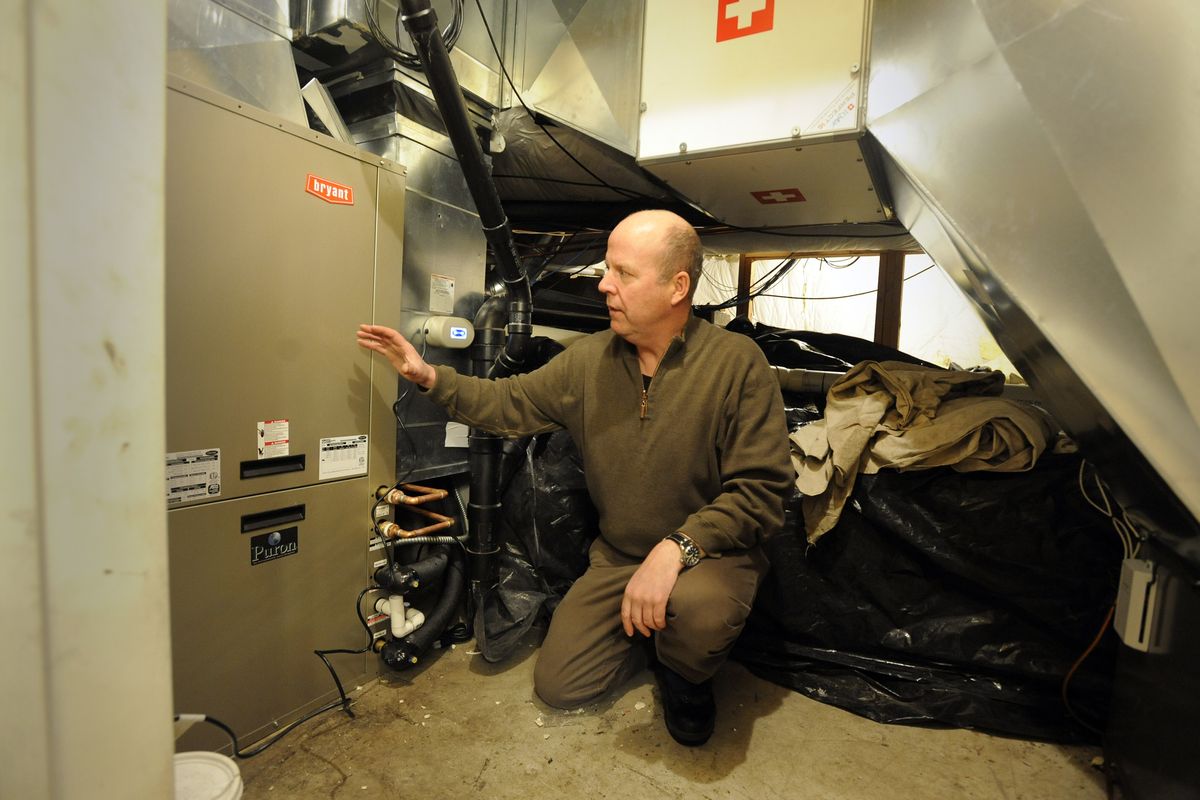Geothermal systems help tame energy bill
Despite federal subsidy, idea isn’t taking hold in Inland Northwest
John Adrain kneels by one of two large heat exchangers that are part of his geothermal heating and cooling system. (Jesse Tinsley)
In part, John Adrain bought his house in northwest Spokane for the great views of forests and peaks.
But those views came at a premium. In the winter, the windows in his two-level home accounted for 80 percent of heat loss. The 3,100-square-foot house, built in the 1990s, primarily relied on two oil furnaces for heat.
Adrain said that during some cold spells he easily spent more than $1,000 per month on heating.
An inventor and entrepreneur, Adrain did some research and decided to install an underground geothermal heating and cooling system.
“It’s great to go out and invest in solar heating. But, for me, the first step was to reduce the amount of energy I’m using,” he said.
After three months of work, Adrain recently watched as workers hauled the oil furnaces to the dump. His home now hums along on a new geothermal system that also provides him a 30 percent tax credit on the cost of installation, including the hefty price for drilling the eight wells.
He expects to save between $7,000 and $10,000 a year for heating and cooling.
As oil and gas prices trend upward, some homeowners are looking at the option of geothermal energy to heat and cool their houses. But even with a 30 percent federal tax credit, local companies haven’t seen the demand increase in the past year.
Northwest Geothermal, the Hayden contractor hired by Adrain, does about one geothermal installation a month, owner Jason Bartel said.
Spokane-based Holliday Heating & Air Conditioning, a company that’s been installing geothermal systems for about 15 years, also does about one system per month.
The main effect of the tax credit has been an increase in the number of local companies offering to install geothermal systems, said John Munro, main sales representative for Holliday Heating.
“Even with the tax credit, people are not looking at geothermal unless they were already looking at geothermal before,” Munro said.
“It did push a few of those people over the top to buy a system,” he said. And many of those are people with large houses dealing with steep energy costs, Munro said.
That would describe Adrain, who said he hopes to recoup the cost of installation in four or five years. He chose to not disclose the full cost of what he paid to install the system.
“All I know,” said Adrain, “is that the price of oil and electricity will increase, and the cost of this (geothermal) system should not increase much at all.”
Avista Utilities does not provide incentives for residents installing such systems. Company spokeswoman Debbie Simock said the payback takes too long for the amount of energy saved.
Adrain’s geothermal system takes cooled 37-degree water and pumps it underground through three-quarter-inch plastic pipes to a depth of 200 feet. There, the cool water absorbs ground heat and goes back up the loop, where it re-enters the house at roughly 50 degrees.
Once back inside the house, two heat-exchangers in the basement remove the heat from the water and blow it across the home using standard air ducts.
In the summer, the process is reversed, with the added savings benefit of using heat taken out of the house to preheat Adrain’s hot water tanks. The main advantage is that geothermal systems can count on ground temperatures remaining steady any time of year, Bartel added.
Adrain’s system uses eight wells, all at 200 feet, to provide enough heat transfer to keep the house comfortable.
A number of regional companies or businesses have installed systems pulling water from the aquifer for geothermal cooling and heating. In those cases the systems first needed state approval to remove water from underground and put it back in, with no contamination.
In a closed-loop geothermal system like Adrain’s, no water is removed from or added to the ground. The system uses a fixed volume of water in the pipes and recirculates it.
Washington regulates the construction of the wells drilled for closed-loop geothermal, said Ecology Department spokesman Bill Lum. Adrain needed to use a licensed well driller, he added.
The polymer lines used for the wells are durable and are guaranteed for 60 years, Munro said. “They’re also butt-welded so they use the same technology that is used for underground gas lines.” Munro said the big change in recent years is the improved technology that keeps the systems working efficiently. The key factors are consistent water flow in the pipes that send cool water below ground and up to the heat exchanger in the house.
“When people don’t properly design the system and know the right amount of water line to use, it can cause problems” such as inefficient heat transfer and loss of energy, he said.
“Anyone can do it, but doing it right is the big question people need to think about,” he said.

